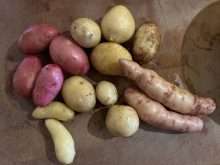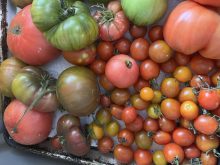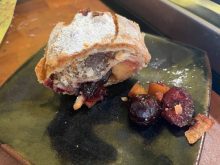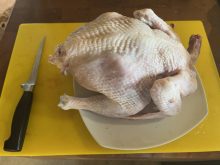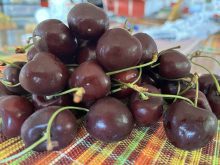In early May 2018, I spent a few days in Vancouver with my youngest son Dailyn and his partner Rachel. They were both running in the Vancouver marathon, and I was running my first half-marathon. I couldn’t think of a better place to enter the game: a flat, fast course, the seawall, Stanley Park. I had lived in Vancouver as a younger woman, loved the city, and for a long time regretted leaving. Coming back to run was redemption — and a license to eat.
For three days before the race, I ate my way through as many places as I could. On race morning, nervous as the proverbial cat, I ate only my normal handful of almonds pre-race. But when we finished running, all three of us were starving. We walked from downtown Vancouver toward our B&B in Kitsilano, stopping several times along the way to dine. At one lovely breakfast bistro on our long walk — our second pitstop! — Dailyn ordered a plate of Liège waffles to share. Liège waffles always make my eyeballs roll back into my head, and these were no exception.
Waffles date back to the ancient Greeks, who cooked them between a pair of long-handled metal plates over an open flame. They’ve been popular in Europe for centuries, especially in the Low Countries (Belgium, Luxembourg, the Netherlands) where numerous yeast-based variants arose. Modern North American waffles are a quick batter, leavened with baking powder or baking soda and buttermilk. Sourdough waffles, one of my faves, are a thicker batter leavened with starter, and require a day or two head start, as do Liège waffles.

Liège waffles reportedly began in Belgium, but the recipe first appeared in an 1814 French cookbook by the first-ever restaurateur, Antoine Beauvilliers, who opened the first public establishment after the French Revolution, when the rich aristocratic patrons of most chefs lost their lives. Liège waffles are the aristocratic pastry of the waffle world, made with a brioche-like egg dough: yeasted, buttery, but dense and chewy in a way that brioche is not, with pearl sugar studded throughout for sweet pockets and a divinely caramelized exterior. You could eat them with a knife and fork, adorned with whipped cream, fruit and syrup, but I like them plain, eaten out of hand to let the interplay between the caramel and those contrasting textures shine. Think of them as a better-pedigreed cinnamon bun.

When I got back to my prairie kitchen, I took a hard look at my waffle maker. It’s at least 20 years old and a bit beat up, but still does its job without sticking or burning or any other sorry complaints that afflict some waffle makers. I figured it would do the trick.

Liège waffles are rich, thus small, and roughly round, so after a trial-run single, I grilled two small, rough-edged waffles at a time. Each pair left a little melted pearl sugar behind on the metal plates, to add a bit more caramel to the next set. And yes, they were every bit as good as the ones we ate in that spiffy breakfast bistro.

The combo of caramel and densely chewy texture makes them a luxurious treat, one that my husband Dave is prone to eat at room temperature, day or evening. I agree: Liège waffles are bigger than breakfast. First we eat, then we taste-test toppings.

Liège waffles
This dough is made as if making brioche: slowly smear in the softened butter to form a rich dough. Leftovers freeze well.
Makes 16 waffles.
- ¾ cup warm milk
- 2 Tbsp brown sugar
- 1 Tbsp active dry yeast
- 2 large eggs
- 1 tsp. vanilla extract
- 3 cups all-purpose flour
- 1 tsp kosher salt
- ½ cup unsalted butter, softened
1 cup pearl sugar (see Cook’s Note)
Combine the milk, sugar and yeast in a mixing bowl. Let stand about 5 minutes or until yeast bubbles up. Add the eggs and vanilla. Mix well. Add three-quarters of the flour and the salt. Mix well using a dough hook if using a machine.
Read Also

Gentle treatments for pain in the neck
Heading toward year-end, people unknowingly tense up against the cold and busyness, causing neck pain that can often be treated with appropriate support and gentle mobility, athletic therapist Kathlyn Hossack says.
Add the butter, one tablespoon at a time, scraping down the bowl each time so it is entirely blended before adding more.
Add the remaining flour. Knead for 5 minutes until well formed, finishing by hand. Transfer to bowl, cover, and refrigerate to rise overnight.
Next day, preheat waffle maker. Remove waffle dough from fridge, deflate gently and work in the pearl sugar. Use a pastry scraper to divide into 16 even pieces. Shape into balls and roll them in any discarded pearl sugar. Let the raw balls rest on the counter and flatten with the palm of your hand immediately before setting each on the waffle maker. Cook for 3 to 5 minutes. Serve immediately, at room temperature, or reheat in the oven (375 F) for 10 minutes.
Cook’s Note: Pearl sugar is costly to buy, but it’s inexpensive and trouble-free to make your own. Combine 2 cups of white sugar with 2 Tbsp water in a heavy-bottomed pan. Stir frequently while simmering for 30 minutes until the sugar re-crystalizes, then let it dry slowly without caramelizing. Turn out onto a parchment-lined tray and cool. Pick out the pearl-sized pieces for use, breaking larger pieces to fit if needed.




